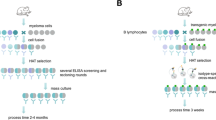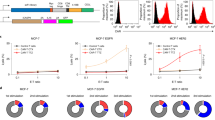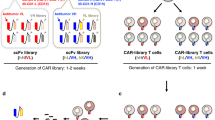Abstract
FUSION of myeloma cells which grow in tissue culture with spleen cells from an immunised mouse provides a general method for obtaining cell lines (hybridomas) which make antibody of the desired specificity1–3. Hybrids derived from these myelomas make the immunoglobulin (Ig) heavy and light chains of the myeloma parent as well as the antigen-specific heavy and light chains of the spleen cell parent. In conditions in which the two heavy and two light chains associate randomly, a hybridoma would make 10 distinct Ig molecules, and the specific antibody would comprise only 1/16 of the total Ig4,5. To obtain hybridomas making only the specific antibodies requires a tumour cell fusion partner that itself makes no Ig but which can nevertheless be fused with spleen cells to obtain hybrids secreting only the specific antibody. We report here the identification of such a cell line, Sp2/0-Ag14.
This is a preview of subscription content, access via your institution
Access options
Subscribe to this journal
Receive 51 print issues and online access
$199.00 per year
only $3.90 per issue
Buy this article
- Purchase on Springer Link
- Instant access to full article PDF
Prices may be subject to local taxes which are calculated during checkout
Similar content being viewed by others
References
Köhler, G. & Milstein, C. Nature 256, 495–497 (1975).
Köhler, G. & Milstein, C. Eur. J. Immun. 6, 511–519 (1976).
Current Topics in Microbiology and Immunology (eds Melchers, F., Potter, M. & Warner, N.) (Springer, Berlin, in the press).
Köhler, G., Hengartner, H. & Shulman, M. Eur. J. Immun. 8, 82–88 (1978).
Shulman, M. & Köhler, G. Nature 274, 917–919 (1978).
Köhler, G. & Shulman, M. in Current Topics in Microbiology and Immunology 143–149 (Springer, Berlin, 1978).
Andersson, J. & Melchers, F. in Current Topics in Microbiology and Immunology 130–140 (Springer, Berlin, 1978).
Andersson, J., Coutinho, A. & Melchers, F. J. exp. Med. 145, 1520–1530 (1977).
Galfre, G., Howe, S., Milstein, C., Butcher, G. & Howard, J. Nature 266, 550–552 (1977).
Gronowitz, E., Coutinho, A. & Melchers, F. Eur. J. Immun. 6, 588–590 (1976).
Cotton, R., Secher, D. & Milstein, C. Eur. J. Immun. 3, 135–140 (1973).
Shulman, M. in Research Methods in Immunology (eds Lefkovits, I. & Pernis, B.) (Academic, New York, in the press).
Author information
Authors and Affiliations
Rights and permissions
About this article
Cite this article
SHULMAN, M., WILDE, C. & KÖHLER, G. A better cell line for making hybridomas secreting specific antibodies. Nature 276, 269–270 (1978). https://doi.org/10.1038/276269a0
Received:
Accepted:
Issue Date:
DOI: https://doi.org/10.1038/276269a0
This article is cited by
-
High-volume hybridoma sequencing on the NeuroMabSeq platform enables efficient generation of recombinant monoclonal antibodies and scFvs for neuroscience research
Scientific Reports (2023)
-
Hybridoma technology; advancements, clinical significance, and future aspects
Journal of Genetic Engineering and Biotechnology (2021)
-
Cartilage-binding antibodies initiate joint inflammation and promote chronic erosive arthritis
Arthritis Research & Therapy (2020)
-
BW5147 and Derivatives for the Study of T Cells and their Antigen Receptors
Archivum Immunologiae et Therapiae Experimentalis (2020)
-
Human monoclonal antibodies as candidate therapeutics against emerging viruses
Frontiers of Medicine (2017)
Comments
By submitting a comment you agree to abide by our Terms and Community Guidelines. If you find something abusive or that does not comply with our terms or guidelines please flag it as inappropriate.



